How Square Enix Approached Accessibility In Final Fantasy 16
I recently previewed Final Fantasy XVI, going hands-on with the upcoming game for roughly two hours. I learned a lot about the game, which is due out on PlayStation 5 this summer, including how developer Creative Business Unit III approached accessibility in FFXVI.
You won’t find difficulty settings like easy, medium, and hard. Instead, there’s a story-focused mode and an action-focused mode. The story-focused mode will be easier, while the action-focused mode appears to be the default difficulty setting. And within each of these modes, there are special accessories that can be equipped to tailor the difficulty of combat to your liking. I was able to use five – I’m not sure if there are more – and I liked how easy it was to swap them in and out, and the effects on my in-game combat actions were great. It’s quick, easy to understand, and effective.
Here Are The Five Accessories I Previewed
Ring of Timely Focus: With this equipped, right before an enemy hits you, time slows almost to a halt. You’ll see an R1 button prompt appear on screen with a circle depleting around it to indicate how much time you have left. R1 is the dodge button, so this setting makes dodging away from enemy attacks much easier.
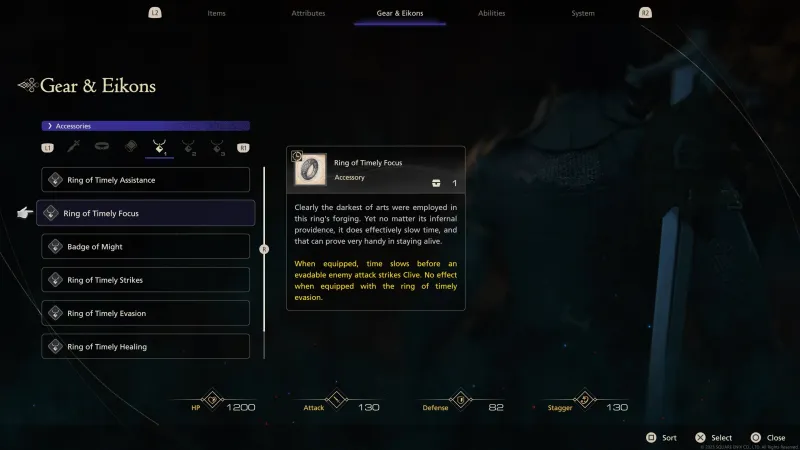
Ring of Timely Assistance: Clive is joined by a dog named Torgal (yes, you can pet Torgal). You can manually select Torgal’s attacks, but wearing this ring lets Torgal attack automatically.
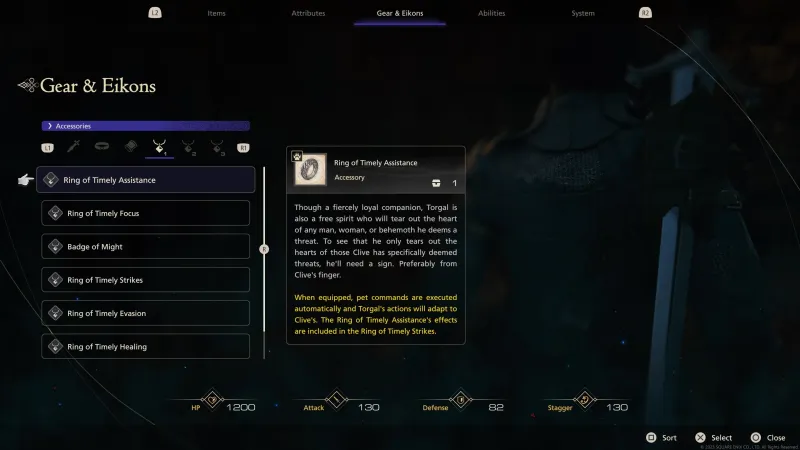
Ring of Timely Strikes: Combat in FFXVI revolves around mixing and matching various moves to create combos. With this ring equipped, you can just press Square and Clive will perform the combos automatically. It essentially allows you to complete combat scenarios using one button.
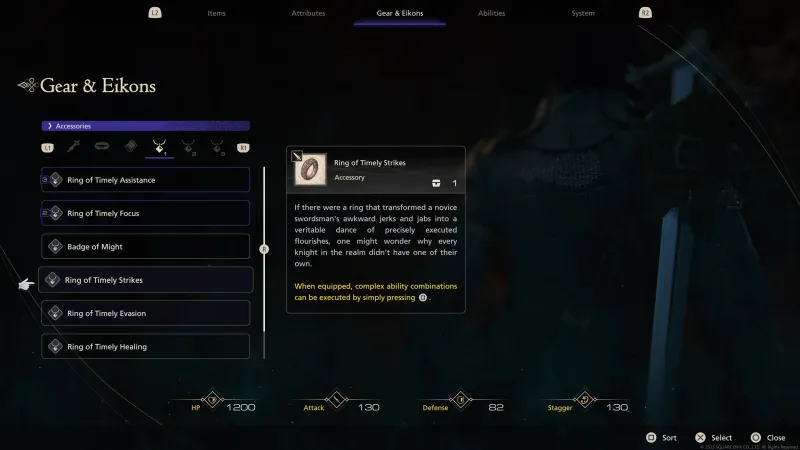
Ring of Timely Evasion: Allows Clive to automatically dodge most attacks.
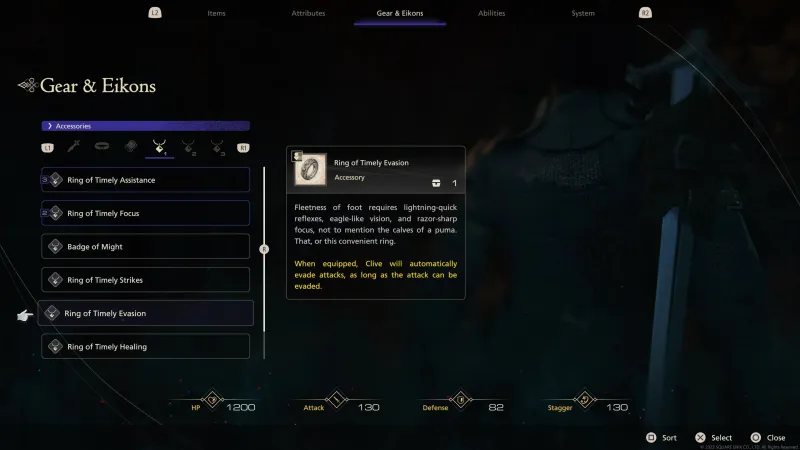
Ring of Timely Healing: When Clive’s HP drops to a certain point, he will automatically use a potion to heal (so long as you still have potions).

During a group interview with FFXVI producer Naoki Yoshida, director Hiroshi Takai, and combat director Ryota Suzuki, the three discussed Creative Business Unit III’s approach to accessibility, especially as it relates to the different modes and accessories listed above.
“To talk about how we got to where we are with this and the idea of making the game as accessible as it is starts off with me being 50 years old,” Yoshida says through a translator. “I have pride as a gamer and so when you first play an action game – I love action games – it always says, ‘What [difficulty level] do you want to play? Easy, medium, or hard?’ And again, because I have pride as a gamer, I don’t want to choose easy. But then, of course…the first time you die, then it comes up, ‘Do you want to switch to easy?’
“I didn’t so I didn’t want players to feel that as well. We wanted to create a system where players wouldn’t be forced into this decision to choose between easy, medium, or hard. We wanted something that felt accessible but also customizable so that each player could create something that felt like a difficulty level that matched them and that was my first order to Takai.”
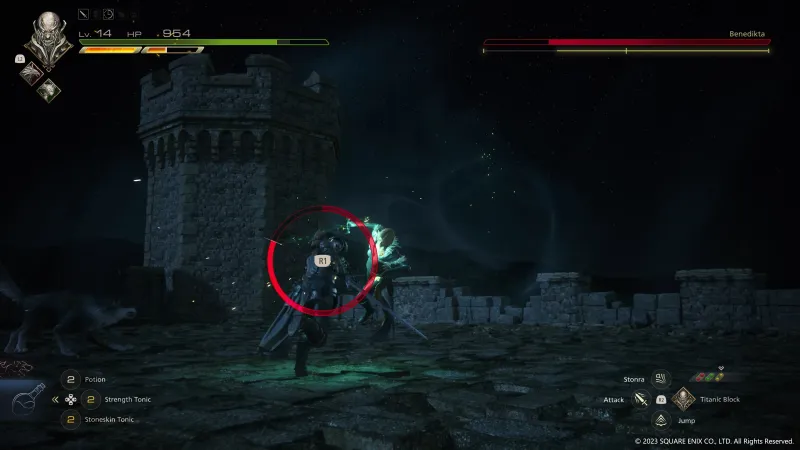
Takai then brings up the rings, citing that the first question he asked himself after Yoshida’s order was, “What type of players are there?”
“And so we listened to players that are maybe not as good at doing combos and attacking,” he says through a translator. “Some players maybe are not as good at dodging as other players. We found out that each of these things that players would not be good at, and then we wanted to create a system that would help players out in those individual areas. And then for me, I told our battle director to make that happen.”
In steps Suzuki, who has a history designing various combat systems across 20 years at Capcom, working on games like Marvel vs. Capcom 2 and Devil May Cry 5. He says that experience has given him a pretty good idea of what action enthusiasts want.
“I know what to create for them…[but] you have a whole audience of players that are maybe not used to this actually,” he says through a translator. “You have fans of the series and fans of the RPG genre. And we couldn’t just make a game for heavy action users. We need to make this game for everyone…and make sure that we include those players as well, so my highest priority was, again, creating something that was accessible to those users who had not played a lot in the action game genre.”
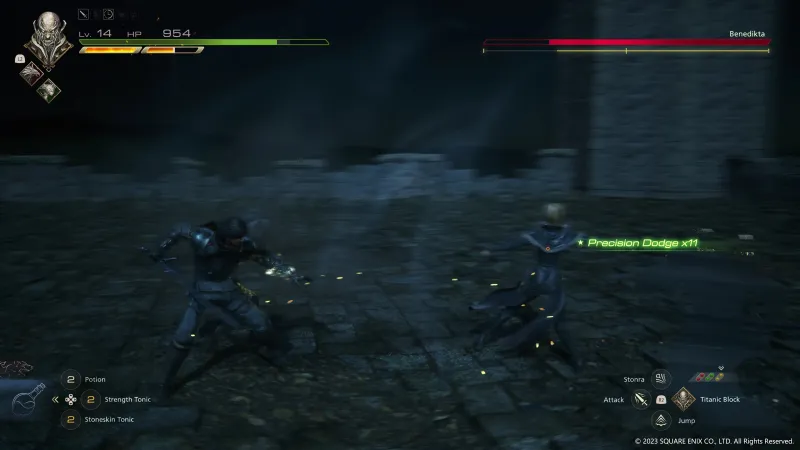
That led to the creation of the accessory system. Suzuki says Creative Business Unit III believes that this system creates something that makes the game accessible to players not as familiar with the action genre while not impeding on what action fans want out of FFXVI.
“We have a high ceiling…but we also lower the floor to make it more accessible.”
Yoshida adds that rather than asking if players want an easy, medium, or hard experience, FFXVI asks, “Do you want to focus on the story or do you want to focus on action?” But from there, he says “it’s all about the player deciding how much story focus and how much action focus they want, and not going to the system and changing the difficulty from the system but changing the difficulty via customizing Clive himself.”
“By customizing [Clive], you can change the difficulty and customize that to your playstyle and I think this is a really, really good and fresh idea.”
I was also able to page through the game’s settings to see what other accessibility features players can expect. It’s important to note that this preview build was not finished and does not reflect the final game, though, so things could change. And if I had to guess, this was not all of the settings we’ll be seeing in the final game.
- Subtitles: There are subtitles, and text size can be adjusted. You can also add a background to the subtitles to make them more visible. There was also a setting for hearing impaired subtitles.
- Chatter Log: There’s a chatter log to view conversations that have taken place, which is great because a lot of conversation happened in the two hours of FFXVI I played – being able to catch back up on what I’ve forgotten, or read what I might have missed while fighting an enemy, is nice.
- Controller Layouts: I didn’t switch controller layouts but the option is there.
- Target Follow: This setting adjusts the camera when a target is offscreen, presumably to move the camera toward them.
- Visual Alerts: This was described in the settings as an on-screen waveform that acts as a visual representation of in-game sounds and music. You can adjust the size and opacity of visual alerts.
There are also other mainstays like the ability to adjust camera controls, audio volumes, and more as well. But again, we won’t know the full depth of the settings until Final Fantasy XVI hits PlayStation 5 on June 22.





